In this third mini solo, I’m playing over a groovy Aeolian blues track in the key of C minor. Before we look at what is going on here in a bit more detail, here are the key downloads you need when working through this lesson:
Groovy Aeolian Blues In C Minor Backing Track
Groovy Aeolian Blues In C Minor Backing Track Tab
The first of these is the backing track that I am soloing over, which you can use to play over and create your own ideas, as well as practice the mini solo tabbed out below.
The second is the tab for the backing track, which illustrates the chords in the backing track and how to play them.
Finally, the last download shows the 5 shapes of the C Aeolian mode.
These scale diagrams show my suggested fingerings for the scale, and the tonic notes of C are highlighted in each position.
So if you don’t yet feel totally comfortable with these scale shapes, you can refer to them when creating your own ideas.
The tab for this third mini solo is as follows:
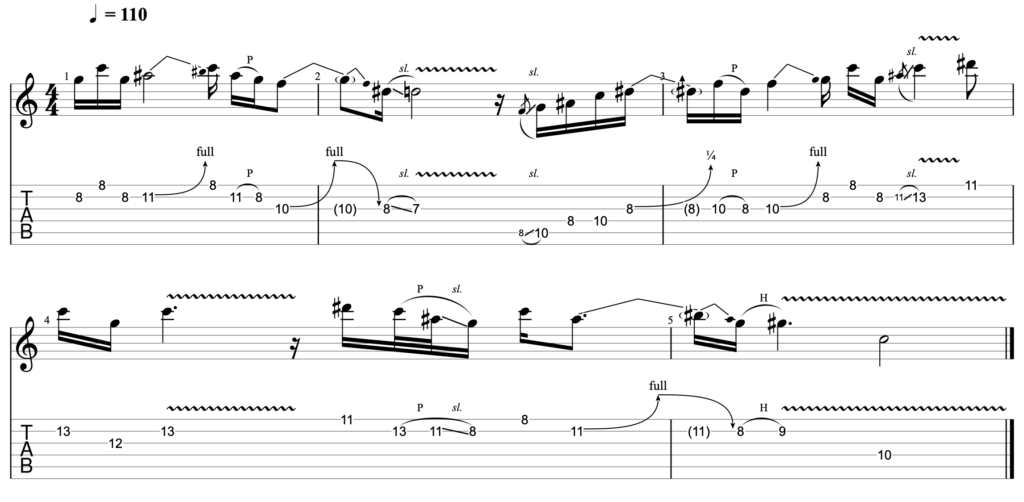
At the 110 beats per minute (BPM) at which the track is played, the isolated audio for the guitar part is as follows:
Musical context
The backing track that we are playing over here is in the key of C minor.
The track loosely follows a fairly typical minor 12 bar blues progression. In fact, the chord movements are not that dissimilar from those which appear in ‘The Thrill Is Gone‘, by B.B. King.
The distinction that this is a minor blues progression is important, as 12 bar blues progressions in minor keys often involve more chords and changes than a major blues.
The full explanation as to why this is the case is quite involved and as such goes beyond the scope of this lesson. If you would like more information on this, then I discuss it in greater depth in this article here.
In short though, when you turn all of the chords in a standard I, IV, V major blues progression into minor chords, the impact of the turnaround diminishes.
The content of a minor V chord does not create the same tension and ‘pull’ back to the I chord. This means that some of the tension of the turnaround section is lost.
This is significant, as the turnaround is the most interesting part in any blues progression.
To get around this and benefit from the melancholic feel of a minor progression – whilst also playing an effective turnaround – musicians typically alter the chords in the turnaround section, or add in extra chords alongside the I, IV, V.
This is exactly what happens in this backing track. The specific chords which appear in this progression are as follows:
Cm7 | Fm7 | Ab9 | Fadd9 | Cm7 | G7b13
The I and IV chords here are both as you would expect. In the turnaround section however, everything changes.
Ab9 is added in as a flattened VI chord, the IV chord of Fm7 is turned into an Fadd9 chord, and the V chord is turned into a 7b13 chord, which has a very jazzy and angular feel.
These alterations move quite far beyond what you would expect to encounter in a typical minor blues. It is for this reason that the track takes on a jazzier and slightly groovier feel.
These alterations in the turnaround section however, are indicative of the kind of changes you encounter in a minor blues.
As you can hear in the track, the tension ramps up throughout the turnaround and there is a strong harmonic ‘pull’ from the G7b13 back to the Cm7 chord.
Keeping things simple
For more advanced players, the specific chords used in this backing track are important. They provide you with more options as a soloist, along with the opportunity to create some quite jazzy lines through chord tone targeting.
If you are not yet at this stage, then the good news is that you don’t need to get weighed down by scrutinising the specific chords in the progression.
The key pieces of theory that you can take from this lesson and which will be useful moving forwards are as follows:
- You can create minor blues progressions by turning the I, IV, V chords of a major blues into minor chords or minor 7th chords
- The impact of the turnaround section in minor blues progressions is diminished, as there is not the same strong pull back from the V chord to the I chord
- As such, you will often encounter alterations to the chords in a minor blues turnaround, or you will see new chords added into the turnaround
From a soloing perspective, you have a variety of options when playing over a minor blues.
In my solo above I use what is known as the Aeolian mode, or the full natural minor scale. I think this fits very well over the track. It also provides me with more options and flavours to target in my solo.
Opting for the same scale will provide you will all of the same benefits. As such, the following discussion in this lesson is based around the Aeolian mode and how to use it.
If you don’t yet feel comfortable to move beyond the minor pentatonic scale though, don’t worry! You can use the C minor pentatonic scale over this entire track and doing so will create a beautiful and bluesy sound.
If you do feel ready to move beyond the minor pentatonic scale and experiment with the Aeolian mode, then let’s dive into it!
Key learning points
In the previous lessons of this course, I shared three or four key ideas that you can focus on for each solo. As such, the discussions have been varied – and covered elements like phrasing, technique and note choice.
Here, the discussion will be slightly different.
This is because unlike in the previous mini solos of this course, in this improvisation I move beyond the minor pentatonic scale. As noted above, I play what is known as the Aeolian mode, or the full natural minor scale.
As such, I want to focus the discussion here on what the Aeolian mode is, why you might want to use it, and how you can incorporate it in your playing.
I won’t dive too deep into the theory here, as things can quickly get very involved.
If you do want to learn all about this scale and the modes more generally though, then I would recommend heading to this full course – ‘Getting Started With The Modes‘. I cover the topic there in much more depth.
The good news though, is that with just a little theory you can learn when to use this scale and how to effectively incorporate it in your blues playing.
So with that in mind, let’s have a look at the scale in a bit more detail:
The Aeolian mode
The Aeolian mode is a minor scale made up of seven notes. The intervals present in the scale are as follows:
1 2 b3 4 5 b6 b7
As a result of its minor tonality, you should use the Aeolian mode when you are playing over minor chord progressions like this one.
There is more nuance to this discussion, but if you are just getting started with this scale, this is the key point to keep in mind.
In the key of C, this is how the first shape of the Aeolian mode appears on the fretboard:
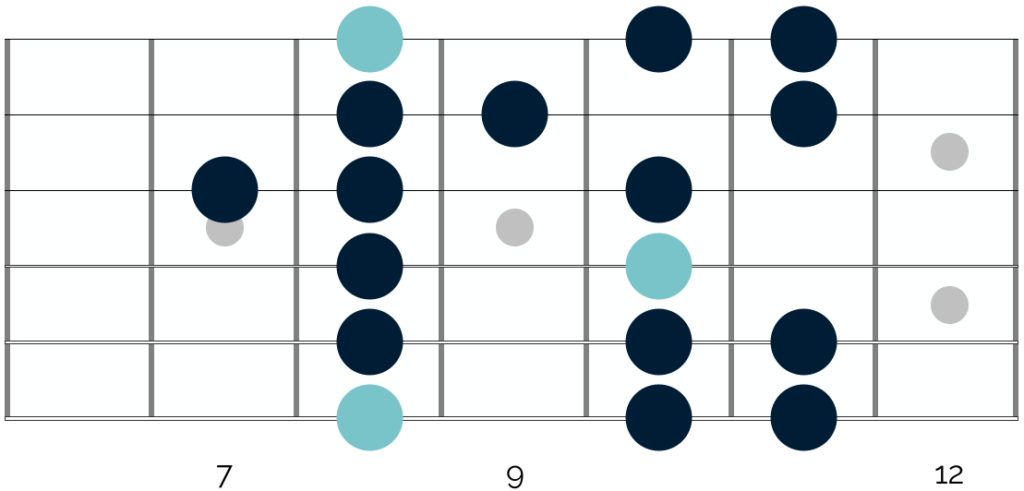
This might look like a totally new scale shape. However ‘hiding’ within the scale is the very familiar shape of the minor pentatonic.
This is because the Aeolian mode contains all 5 notes of the minor pentatonic scale, in addition to 2 more notes (which appear in both octaves of the scale).
You can see this on the following diagram with the scales side by side:
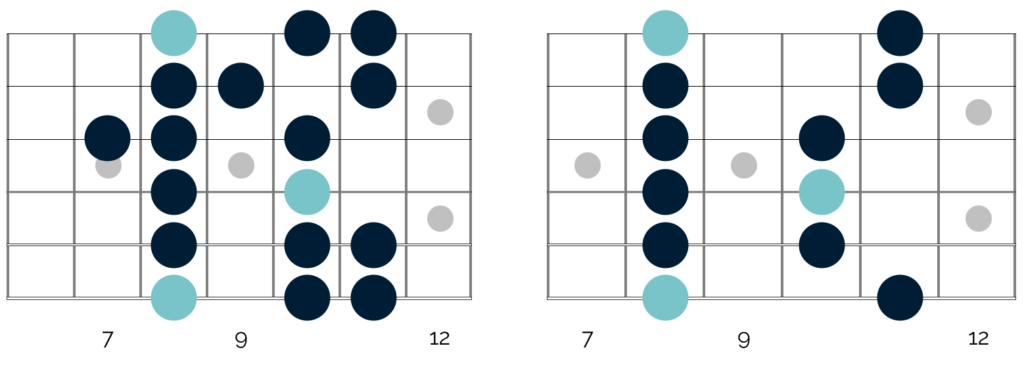
When laid out in this way, hopefully you can see the relationship between the two scales.
We can illustrate this another way if we look at the first shape of the C Aeolian mode, with the notes that appear just in this scale shown in white:
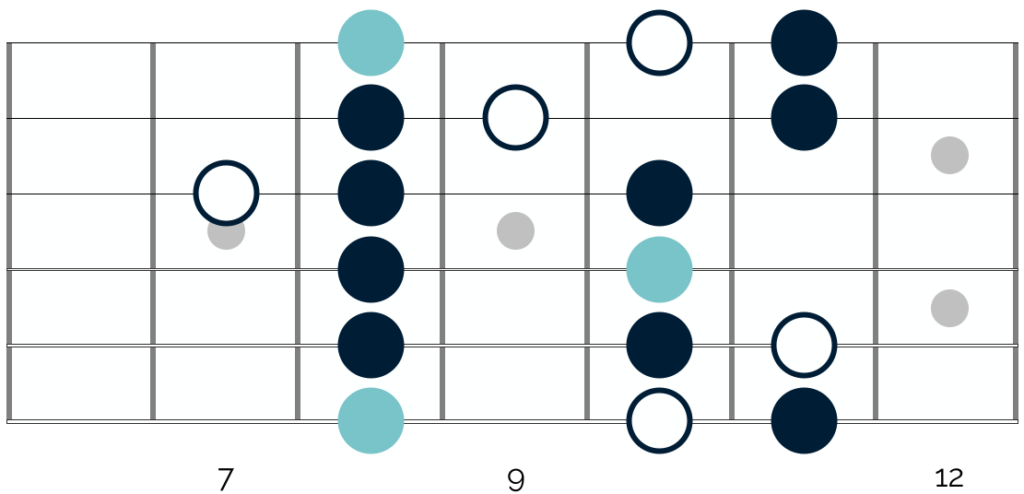
As in the previous diagram, hopefully you can see the minor pentatonic scale ‘hidden’ within the broader shape of the Aeolian mode.
I have focused on the first shapes of both scales here for ease. However it is important to note that this relationship exists across all 5 shapes of both scales.
In other words, the first shape of the Aeolian mode contains all 5 notes of the first shape of the minor pentatonic scale, in addition to 2 extra notes.
The second shape of the Aeolian mode contains all 5 notes of the second shape of the minor pentatonic scale and so on.
Understanding this connection is extremely useful for two key reasons, which both relate to using the Aeolian mode in your playing.
With that in mind then, let’s turn our attention to the steps you can take to start using the mode when soloing.
Step 1 – Start with the pentatonics
The biggest mistake I observe in players learning the modes is that they leave all of their familiar licks and ideas behind.
They treat the modes as completely new scales, and then struggle to create licks and navigate across the scale effectively.
Appreciating the concept covered above prevents this from happening. When you understand that all of your familiar pentatonic shapes are contained within the Aeolian mode, you can take a pentatonic first approach.
In other words – rather than thinking about playing a new and different scale – you can think about playing the relevant pentatonic scale, and then enhancing it with the additional notes of the mode.
I do this consistently throughout the improvisation above:

As you can see from the tab, most of what I am playing sits firmly within the minor pentatonic scale. Not only this, but I am playing what could be described as fairly ‘standard’ blues licks.
I then just add to and enhance these with a few choice notes from the Aeolian mode (more on this below).
If you take this same approach, you can use all of your ‘go-to’ minor pentatonic blues licks. You can then think about adding some of the specific Aeolian notes into your phrases after that.
The obvious benefit of this is that you don’t have to leave behind all of the licks and phrases you have created using the minor pentatonic scale.
This puts you into a strong starting position and prevents you from feeling lost or overwhelmed with the modal scales.
Taking a pentatonic first approach also ensures that your playing retains a distinctly bluesy flavour.
The minor pentatonic scale defines the sound of the blues and so should remain at the centre of your approach, even when you begin using other scales.
Step 2 – Add the modal flavour
Thinking in terms of the minor pentatonic scale first also allows you to better bring out the flavour of the Aeolian mode.
As noted above, 5 of the 7 notes from the Aeolian mode are found within the minor pentatonic scale. This in turn means that there are 2 notes in the Aeolian mode which are not found in the minor pentatonic.
These differentiating notes are what give the mode its flavour.
By consciously targeting these notes as ‘modal notes’ alongside the pentatonic, you can bring out the specific sound of the Aeolian mode with greater clarity.
You can see the ‘new’ notes of the Aeolian mode highlighted in yellow in the key of C on the following diagram:
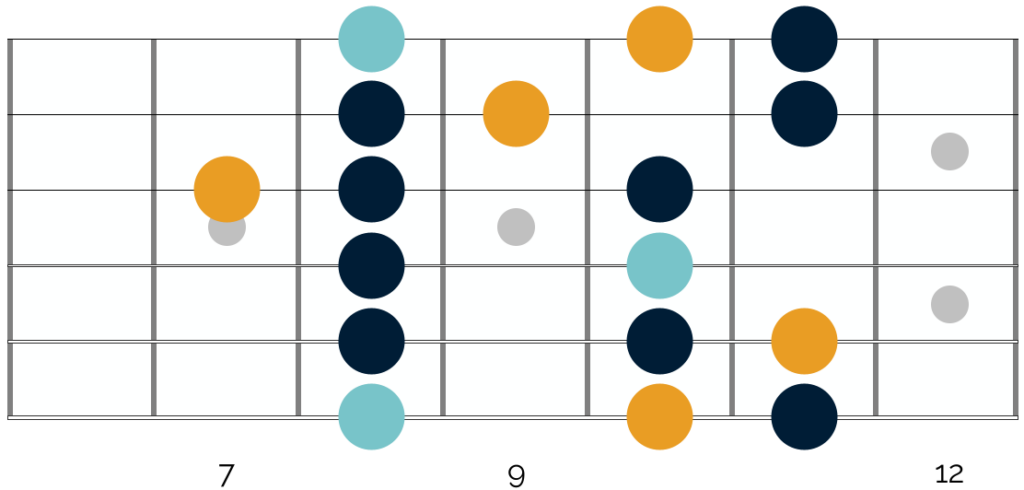
These notes are not found in the minor pentatonic. As such, when you target them in your solo, you will immediately create a different feel in your playing.
You can see and hear me do this in my improvisation above. Specifically, I target the 7th fret on the G string and then the 9th fret on the B string.
When I do this, it fundamentally alters the feel of the solo. The improvisation takes on a different character and moves it beyond a classical blues solo.
This is a common approach that guitarists often adopt in their playing. In fact, if you have ever heard a solo that contains bluesy elements, but which also contains additional flavours that you can’t quite identify, it is likely that it makes use of a modal scale.
A few examples of songs and solos which use the Aeolian mode are as follows:
- The Thrill Is Gone – B.B. King
- Still Got The Blues – Gary Moore
- All Along The Watchtower – Jimi Hendrix
- Black Magic Woman – Carlos Santana
- Slow Dancing In A Burning Room – John Mayer
Listen to each of these examples and try to identify the sections in the lead playing that sound like they aren’t crafted using the minor pentatonic scale.
Those will be the sections where the players are using the Aeolian mode.
Step 3 – Play with intention
If you have listened to the songs listed above, then you will have hopefully noticed that they fall across a spectrum.
For example, the Thrill Is Gone sounds very much like a ‘classic’ blues song. Conversely, you would never categorise Carlos Santana’s version of ‘Black Magic Woman’ as a typical blues song.
There are a number of factors that influence this different feel. One of the most significant of these however is the frequency and way that King and Santana use the additional colour tones of the Aeolian mode.
King sticks almost entirely within the minor pentatonic scale throughout the track, and just adds one or two notes from the Aeolian mode in the whole song.
By comparison, Santana bases most of his phrases around the Aeolian mode. It is largely for this reason that his solos in Black Magic Woman don’t sound typically bluesy.
The key takeaway here is that once you begin to apply this idea in your playing, it is important to do so intentionally.
The Aeolian mode contains colour tones that you can use to add depth and variety to your solos.
It is important to note however, that you need to treat these notes with care. Zoning in on the colour tones of the Aeolian mode can totally change the sound of your playing.
If this is your intention, that’s wonderful!
If however, you want to craft bluesy solos and you find that the character of your lead playing is shifting and you are not sure why, I would recommend taking a step back and assessing why this is the case.
It is most likely that you are doing one of the following three things:
- Playing the colour tones too often
- Holding onto the colour tones for long periods of time
- Resolving phrases on the colour tones
Each of these will really ramp up the modal sound in your playing.
You can see this in the solo that I play above. I only add in two notes from the Aeolian mode. In both cases however, I hold onto those notes for a longer period of time, which enhances the modal sound.
As I only play these two notes, the solo retains its bluesy feel. This would change quickly though, were I to increase the number of notes from the Aeolian mode in the solo.
Keeping the above three points in mind, you can experiment across the Aeolian spectrum.
If you focus mostly on the minor pentatonic scale and add in just one or two notes from the Aeolian mode, you will create a more classically bluesy sound.
Do the opposite and target the Aeolian colour tones, and your solos will take on a different character.
Either option is fine – the most important thing is that you target the mode intentionally. This will ensure that you create the character that you want in your playing, and do so purposefully, rather than accidentally.
Over to you 😁
If up to this point you have been largely focused on the pentatonic scales, then effectively using the Aeolian mode poses a new and interesting challenge.
As I always recommend, tackle this challenge slowly. Start in the first shape of the minor pentatonic scale, and work to add in the new notes of the Aeolian mode.
Experiment with different ways to bring out the flavour of the mode, and to play across the modal spectrum.
Once you feel comfortable to do that, extend the idea across the fretboard. Move to the second shapes, then the third, and so on.
It takes time to introduce a new scale into your playing.
However, by following the steps laid out here, you can break this challenge down into manageable chunks. This will help you to add new flavours into your playing whilst holding onto all of your ‘go-to’ licks and phrases.
On that note, good luck!
Keep me posted with how you get on, and if you want feedback on how you are playing through the mini solo – or on a longer improvisation over the track – just send me a video.
You can reach me on aidan@happybluesman.com and I can provide personalised feedback on your playing and soloing ideas 😁
I’m really looking forward to seeing them!
